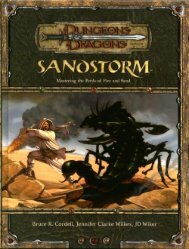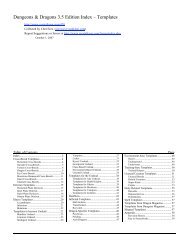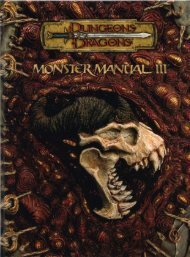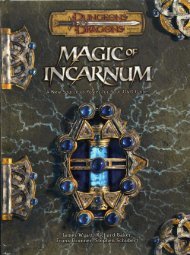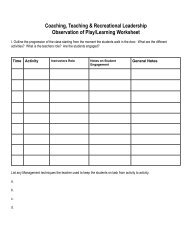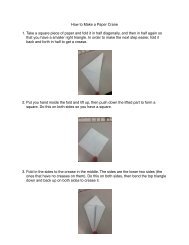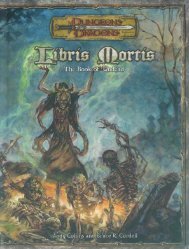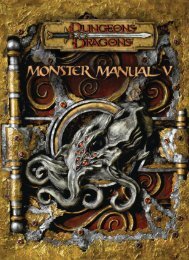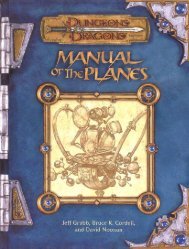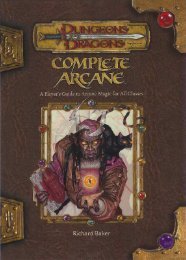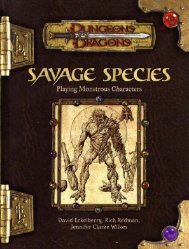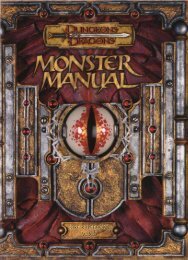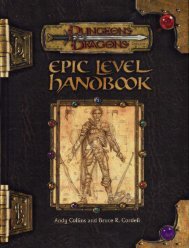CHAPTER 1ELVES6gathered a bit <strong>of</strong> grain and a few sweet herbs from the familygarden plot. Throwing the sack over his shoulder, he nimblyclimbed up the ladder and made his way back home.In the kitchen, he ground the grain and chopped the fruit,then added water and the sweet herbs to make a thin batter.He dropped portions <strong>of</strong> the mixture onto a hot griddle, andsoon had morning cakes piled on a plate and ready to eat.“Mmmm, breakfast!” said Tharivol’s cousin Heiven, rubbinghis hands as he came into the room. Soon the wholefamily was gathered around the table.“Your skill with cooking is improving,” said his great-auntas she helped him clear the table. “As is your aptitude with thebow. I was watching you on the practice range yesterday.”Warmed by Caewenan’s praise, Tharivol grabbed the longbowand longsword that Caewenan’s consort had lent himand headed <strong>of</strong>f to weapons practice.Jyllia and her cousin Quarion joined him, and the threefriends arrived at the archery range together. Today’slesson would be hard—hitting a disk thrown into the airby the instructor.“You must first see your target,” said the young cleric <strong>of</strong>Vandria Gilmadrith gently. “Do not fire blindly unless you canpinpoint the location <strong>of</strong> the disk some other way. Ammunitionis too precious to waste in wartime.” Still, Tharivol grinnedand closed his eyes the next time the disk rose into the air.Listening intently, he tracked the motion <strong>of</strong> the target by thesound it made as it spun through the air. Releasing the tautbowstring at just the right moment, he heard the satisfyingsound <strong>of</strong> the disk shattering.“I am impressed,” said the Master <strong>of</strong> Arms, who had beenwatching the exercise. “Not all have honed their hearing tosuch an extent. I believe it’s time you served in the watch.”Tharivol was delighted, and he promised to report the nextmorning for assignment.“The watch!” exclaimed Jyllia. “I wish I could join.” Thethree finished their target practice and headed for the armoryto practice with their swords. After warming up, they paired<strong>of</strong>f for sparring. Jyllia excelled in close combat, and she bestedTharivol in three out <strong>of</strong> four practice bouts. The instructorshook his head, adjusted Tharivol’s stance, and checked thebalance <strong>of</strong> his weapon. It was no use; Jyllia continued to shine,and Tharivol drew extra practices.Jyllia and Quarion waited for Tharivol to finish; then thethree wandered <strong>of</strong>f to find some lunch. Munching on berriesfrom the bushes around the settlement, fresh peas fromJyllia’s garden, and some bread that Caewenan had baked theprevious day, they chatted about their other projects. Jylliawas studying jewelry making with Quarion’s grandfather,and she was nearly finished making a silver bracelet set withaventurine. Quarion intended to build his own house as soonas he came <strong>of</strong> age, so he was studying architecture under theMaster Builder. As for Tharivol, he was studying magic withhis great-aunt. So far, he had mastered several cantrips, andhe was well on his way to learning real magic.After the three finished eating, Jyllia begged Tharivol fora magic show, and he complied with a bit <strong>of</strong> prestidigitationthat drew a small crowd <strong>of</strong> their friends. Some <strong>of</strong> them pitchedin with their own tricks, and the spontaneous show soonattracted quite a few adults, some <strong>of</strong> whom produced a fewillusions to liven up the party.After the magic show broke up, the three friends went theirseparate ways. Tharivol found his great-aunt in her laboratorywriting scrolls. Taking pen and parchment, Tharivol workedat scribing some <strong>of</strong> his cantrips onto scrolls. After an hour<strong>of</strong> this activity, Caewenan began teaching him the words toa sleep spell. “Reach out with your mind for the power,” shesaid, encouraging him as he tried to learn the arcane wordsfrom her book.Tharivol tried, and he could feel an energy somewhereout there, an energy that was almost palpable, but whichsomehow eluded his grasp. The words didn’t seem to go withthe motions; and when should he toss the sand? Again hetried, and again. Just as he was about to give up, it happened!Understanding flooded his mind as he seized the energy <strong>of</strong>the spell and wrapped his mind around it. Searching aboutfor a target, he spied the caged songbird his aunt kept in thelaboratory, spoke the spell, and the creature promptly stuckits head under its wing and went to sleep.Bursting with pride, Tharivol wrote the spell in his spellbookand put it away for tomorrow. He couldn’t wait to showJyllia what he could do!Now, however, evening was fast approaching, and a dancewas scheduled in the common area under the full moon.Wylmara would be there . . . and maybe this time she woulddance with him.Tharivol went downstairs and helped himself to severalslices <strong>of</strong> the roasted pheasant his cousin had prepared, fillingthe rest <strong>of</strong> his plate with fresh vegetables picked from thefamily’s garden. For dessert, he made himself a fruit puddingwith the rest <strong>of</strong> the berries he had picked at lunchtime. Thenhe retired to his room to paint.Tharivol had learned to paint at his grandfather’s house,where he had last fostered, and he found it a pleasant andrelaxing activity. A sense <strong>of</strong> pleasure filled him as he pickedup his brush and applied himself to the landscape he wasworking on—a view <strong>of</strong> the setting sun across the meadowoutside the village. He could see the scene from his ownwindow, and tonight the sky seemed filled with unusuallybrilliant shades <strong>of</strong> orange, pink, and mauve.When he heard the musicians tuning up outside, he hurriedlychanged into his leather breeches and embroideredshirt and headed outside for the dance. Wylmara was alreadythere, and she accepted his invitation to dance. After onedance, she swirled away into a dance <strong>of</strong> her own, and eventhe elders were applauding when it was over. Then Tharivoldanced with Jyllia, and later joined a complex line dance withthe other young men. On into the night the elves danced,until the full moon hung high in the sky overhead.At last, the dancers began to slip away to their homes, oneby one. Tired but satisfied, Tharivol went up to his own roomand lay down to rest. He knew what he wanted to remembertonight—the thrill <strong>of</strong> memorizing his first real spell. Still,
no elf could predict which memory would surface duringhis trance, so Tharivol savored his day for a moment beforebeginning his meditation.DESCRIPTIONElves are short and willowy in comparison to humans. Theirheight ranges from 4-1/2 feet to 5-1/2 feet, and they generallyweigh between 95 and 135 pounds. Males and females areusually equal in height, though the males tend to be slightlymore muscular. Elves’ lithe bodies are perfectly proportioned,and their movements are almost supernaturally graceful.Most high elves have pale skin and dark hair, though lightershades <strong>of</strong> hair are known in many societies. Neither gendersports any facial hair, and elves’ features are well definedand elegant, though somewhat more angular than those <strong>of</strong>humans. Their almond-shaped eyes are usually green, thoughthey can also be blue, gold, silver, or lavender. Their earssweep upward to pointed ends—a factor that many claimcontributes to their acute hearing.CLOTHINGElves dress in simple, comfortable clothing, though their garbalways has an elegance in keeping with their graceful bearing.Linen, silk, cotton, and wool are common fabrics for elvenclothing, and elves have developed the skill to spin even thecoarsest <strong>of</strong> natural fibers into incredibly fine thread that canbe tightly woven to create s<strong>of</strong>t cloth <strong>of</strong> surprising strength.Leathers and furs are regularly used to endow clothing withstrength and protection. Leather is always tanned to a fine,supple texture. Fur provides both warmth and elegance, andthe elves incorporate it <strong>of</strong>ten into their garb. S<strong>of</strong>t furs suchas rabbit and lynx are preferred over bear and other roughtexturedfurs. Spider silk, certain mosses, and the fibers <strong>of</strong>flower stalks are also spun into cloth. Thistledown treatedwith magic is the material <strong>of</strong> choice for elven cloaks, thoughthe creation <strong>of</strong> this cloth is a lengthy process. Occasionallydifferent fibers are woven together to create tactile interestor to combine the characteristics <strong>of</strong> different materials forpractical reasons. Elves make all their own cloth, seeing thetextiles <strong>of</strong> other races as inferior in quality and workmanship.They occasionally trade with human settlements for rawmaterials, but rarely for finished cloth.Colors and styles <strong>of</strong> clothing vary with individual taste.Many elves prefer muted tones that help them to blend in withthe surrounding forest; others enjoy wearing bright colorsranging in shade from pastels to jewel tones. Dyes are drawnfrom a variety <strong>of</strong> natural sources, most <strong>of</strong> them plant-based.Multihued garments are also reasonably common, thoughthe patterns <strong>of</strong> those colors are rarely geometric. Elves preferirregular swatches <strong>of</strong> coloration that imitate the sun-dappledforest floor or wind-tossed clouds in a stormy sky.Elves see adornment and elegance <strong>of</strong> style as marks <strong>of</strong> ahighly civilized society as well as declarations <strong>of</strong> individuality.A tunic, cloak, or pair <strong>of</strong> trousers may be adorned withembroidery, encrusted with tiny gems, or decorated with bits<strong>of</strong> polished wood. Alternatively, an item <strong>of</strong> clothing may becut or pieced together in some dramatic way. Embroidery canrange from a border done in contrasting thread to a fantasticdesign prominently displayed on a sleeve or bodice. Metallicthreads are sometimes employed for such embellishmentsamong wealthier elves, but the colors <strong>of</strong> nature (ranging frommuted earth tones to the bright colors <strong>of</strong> the sun, the sea, orbrilliant flowers) are more commonly chosen as adornments.Leather and fur may also be dyed, though such materials are<strong>of</strong>ten left natural and adorned in other ways.Fastenings made <strong>of</strong> metal are rare. Base metals are almostnever used in elven clothing, though precious metals mayserve as adornment. Usually, elven clothing is fastened withhooks or buttons made <strong>of</strong> polished wood; carved bone orivory fasteners and leather thongs are also common.Footwear typically consists <strong>of</strong> boots made <strong>of</strong> supple leatheraffixed to sturdy soles made <strong>of</strong> wood or hardened leather;more delicate footgear is sometimes used for ceremonialpurposes. Leather soles secured to the bottoms <strong>of</strong> the feetwith long leather thongs laced up the calf are <strong>of</strong>ten used aslight footgear for dancing and other pursuits requiring onlyminimal protection. Shoes carved in fantastic designs fromcrystal or other precious substances are occasionally used byelf nobles during affairs <strong>of</strong> state.All elven clothing, whether for important ceremonies ordaily wear, is styled for ease <strong>of</strong> use and movement. To anelf, clothing that binds, restricts motion, fails to provideadequate warmth or protection in the situation for which itis intended, or in any way interferes with the business <strong>of</strong> lifeis worse than useless. Quietness is also a key consideration,so elves avoid garb that makes any more noise than therustling <strong>of</strong> leaves.Almost all elves wear jewelry <strong>of</strong> some kind. The materialsmay or may not be <strong>of</strong> exceptional value, but they are alwaysworked to enhance their beauty rather than left rustic andnatural. Circlets, necklaces, earrings, bracelets, armbands,anklets, and rings are common. Designs are invariably lightand airy rather than ostentatious or bulky, and many reflectnature either directly or in some stylized way. Gold or silverpendants shaped like flowers or birds are common, as aresilver circlets whose lines are reminiscent <strong>of</strong> running water.Gemstones are <strong>of</strong>ten incorporated into jewelry designs, usuallyin a manner that integrates them with the whole <strong>of</strong> thepiece. Huge, barely polished gemstones crudely plunked intohammered gold settings are for humans and dwarves; elvesprefer lightness, delicacy, and artistry in their jewelry.Typical garb for a member <strong>of</strong> either gender consists <strong>of</strong> atunic and trousers covered by a cloak. The tunic is usuallymade <strong>of</strong> light, tightly woven material such as fine linen,cotton, or silk, and the trousers are <strong>of</strong>ten made <strong>of</strong> wool spunfine and closely woven. Cloaks are made <strong>of</strong> sturdy clothbecause they serve a variety <strong>of</strong> purposes. An elf may wearone for warmth, wrap himself in it for resting, or spread it onthe ground to sit on. Cloaks for travel are usually dyed green,brown, or some combination <strong>of</strong> those shades to blend in withthe forest, while cloaks worn by nobles within the safety <strong>of</strong>CHAPTER 1ELVES7
- Page 2: C R E D I T SD E S I G NSKIP WILLIA
- Page 9 and 10: premium. Thus, each individual can
- Page 11 and 12: The elves have raised one form of e
- Page 13 and 14: do spend time away from one another
- Page 15 and 16: espects during this time, and those
- Page 17 and 18: Stores Master: Charged with keeping
- Page 19 and 20: would be the birthright of any full
- Page 21 and 22: of feet above the forest floor. Mos
- Page 23 and 24: Cleric Training: More than any othe
- Page 25 and 26: ELF HISTORYAND FOLKLOREThe elves cl
- Page 27 and 28: along with her son Hionyron, who wa
- Page 29 and 30: and return her to her people.” In
- Page 31 and 32: Table 1-3: Suffixesd% Suffix Meanin
- Page 34: CHAPTER 1ELVES34tri-level tree home
- Page 37 and 38: Illus. by C. Lukacsurious and activ
- Page 39 and 40: the reason for the farmer’s hospi
- Page 41 and 42: Halflings make a visitor feel welco
- Page 43 and 44: Halflings are usually pleasant trav
- Page 45 and 46: Halflings are as eager to experienc
- Page 47: A chief or elder heads each clan, c
- Page 50 and 51: CHAPTER 2HALFLINGS50away from their
- Page 52 and 53: CHAPTER 2HALFLINGS52Illus. by S. Wo
- Page 54 and 55:
CHAPTER 2HALFLINGS54to tell how lon
- Page 56 and 57:
CHAPTER 2HALFLINGS56the underbrush
- Page 58 and 59:
CHAPTER 2HALFLINGSIllus. by T. Baxa
- Page 60 and 61:
CHAPTER 2HALFLINGS60Donta muden sit
- Page 63 and 64:
and one or more bedrooms. All have
- Page 65 and 66:
Illus. by C. Lukacshe cliff-dwellin
- Page 67 and 68:
Personality: Raptorans have a reput
- Page 69 and 70:
PSYCHOLOGYSome outsiders who have h
- Page 71 and 72:
for making a point through a logica
- Page 73 and 74:
flock for debate, sometimes invitin
- Page 75 and 76:
its eggs. At such times, they toler
- Page 77 and 78:
THE RAPTORAN PANTHEONThe typical ra
- Page 79 and 80:
Prayers: Prayers to the Stormfather
- Page 81 and 82:
“Welcome, friend,” said a human
- Page 83 and 84:
year since, and they share the care
- Page 85 and 86:
D: Domain spell. Domains: Protectio
- Page 87 and 88:
characteristics are summarized in t
- Page 90 and 91:
CHAPTER 3RAPTORANS90Authority Figur
- Page 92 and 93:
CHAPTER 4OTHERRACES92a humanlike ra
- Page 94 and 95:
CHAPTER 4OTHERRACES94ment, finding
- Page 96 and 97:
CHAPTER 4OTHERRACES96Illus. by S. B
- Page 98 and 99:
Table 4-1: The CentaurHit Base Atta
- Page 100 and 101:
CHAPTER 4OTHERRACES100nomadic gnoll
- Page 102 and 103:
Table 4-2: The GnollBase Fort Ref W
- Page 104 and 105:
CHAPTER 4OTHERRACES104of the humano
- Page 106 and 107:
CHAPTER 4OTHERRACESsneak attack, bu
- Page 108 and 109:
CHAPTER 5PRESTIGECLASSES108Shadowda
- Page 110 and 111:
CHAPTER 5PRESTIGECLASSESIllus. by W
- Page 112 and 113:
CHAPTER 5PRESTIGECLASSES112the foll
- Page 114 and 115:
CHAPTER 5PRESTIGECLASSES114Entry Re
- Page 116 and 117:
CHAPTER 5PRESTIGECLASSESIllus. by J
- Page 118 and 119:
CHAPTER 5PRESTIGECLASSESLUCKSTEALER
- Page 120 and 121:
CHAPTER 5PRESTIGECLASSESIllus. by J
- Page 122 and 123:
CHAPTER 5PRESTIGECLASSESEL 11: Kuly
- Page 124 and 125:
CHAPTER 5PRESTIGECLASSES124spellcas
- Page 126 and 127:
CHAPTER 5PRESTIGECLASSES126save bon
- Page 128 and 129:
CHAPTER 5PRESTIGECLASSESmore than o
- Page 130 and 131:
CHAPTER 5PRESTIGECLASSES130raptoran
- Page 132 and 133:
CHAPTER 5PRESTIGECLASSES132Table 5-
- Page 134 and 135:
CHAPTER 5PRESTIGECLASSESfriendly—
- Page 136 and 137:
CHAPTER 5PRESTIGECLASSESYou no long
- Page 138 and 139:
CHAPTER 5PRESTIGECLASSES138small fe
- Page 140 and 141:
CHAPTER 5PRESTIGECLASSES140ranger.
- Page 142 and 143:
CHAPTER 5PRESTIGECLASSESIllus. by T
- Page 144 and 145:
CHAPTER 5PRESTIGECLASSESEncountersP
- Page 146 and 147:
CHAPTER 6CHARACTEROPTIONS146Conditi
- Page 148 and 149:
CHAPTER 6CHARACTEROPTIONS148If the
- Page 150 and 151:
CHAPTER 6CHARACTEROPTIONSIllus. by
- Page 152 and 153:
CHAPTER 6CHARACTEROPTIONSIllus. by
- Page 154 and 155:
CHAPTER 6CHARACTEROPTIONSIllus. by
- Page 156 and 157:
Table 6-3: Elf Ranger Racial Substi
- Page 158 and 159:
Table 6-5: Halfling Druid Racial Su
- Page 160 and 161:
CHAPTER 6CHARACTEROPTIONS160Table 6
- Page 162 and 163:
Class SkillsRaptoran fighter substi
- Page 164 and 165:
CHAPTER 7EQUIPMENTAND MAGICIllus. b
- Page 166 and 167:
CHAPTER 7EQUIPMENTAND MAGIC166anoth
- Page 168 and 169:
CHAPTER 7EQUIPMENTAND MAGICTable 7-
- Page 170 and 171:
CHAPTER 7EQUIPMENTAND MAGICIllus. b
- Page 172 and 173:
CHAPTER 7EQUIPMENTAND MAGICIllus. b
- Page 174 and 175:
2nd-Level Ranger SpellWoodland Veil
- Page 176 and 177:
WOODLAND VEILIllusion (Glamer)Level
- Page 178 and 179:
CHAPTER 8CAMPAIGNS INTHE WILD178THE
- Page 180 and 181:
CHAPTER 8CAMPAIGNS INTHE WILDIllus.
- Page 182 and 183:
CHAPTER 8CAMPAIGNS INTHE WILD182(lo
- Page 184 and 185:
CHAPTER 8CAMPAIGNS INTHE WILD184Ski
- Page 186 and 187:
CHAPTER 8CAMPAIGNS INTHE WILD186Tab
- Page 188 and 189:
CHAPTER 8CAMPAIGNS INTHE WILDIllus.
- Page 190 and 191:
CHAPTER 8CAMPAIGNS INTHE WILDIllus.
- Page 192:
APPENDIX19261 Guards are needed to
- Page 195 and 196:
2THE CLIFFThe Rifinti dwelling lies
- Page 198 and 199:
supplies for craftwork. Lamps fuele
- Page 200 and 201:
Nae’fidrim: Female owl companion;
- Page 202 and 203:
Creatures: A cleric is always on du
- Page 204 and 205:
cloak of elvenkind, oil of magic we
- Page 206:
aptoran contraries. If visitors can



